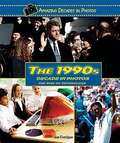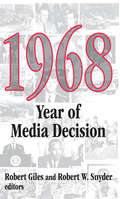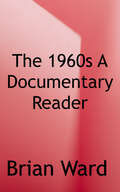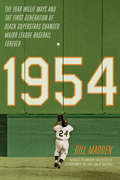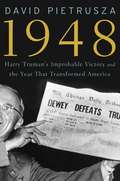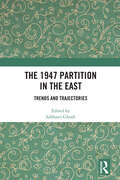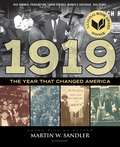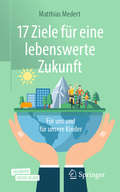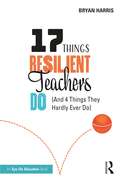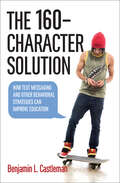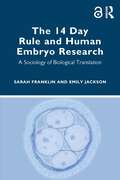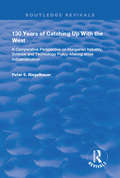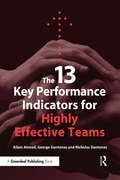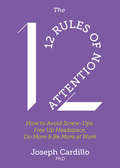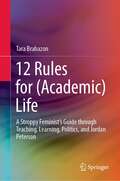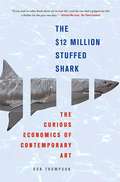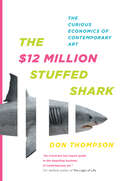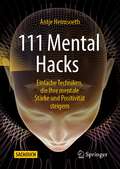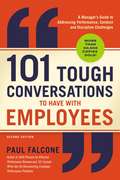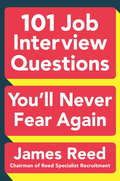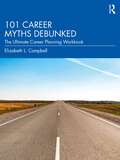- Table View
- List View
The 1990s Decade in Photos: The Rise of Technology (Amazing Decades in Photos)
by Jim CorriganMiddle school readers will find out about the important world, national, and cultural developments of the decade 1990-1999.
1968: Year of Media Decision
by Robert Giles Robert W. SnyderThirty years ago American political life was all relentless, painful, and confounding: the Tet Offensive brought new intensity to the Vietnam War; President Lyndon Johnson would not seek re-election; Martin Luther King, Jr. and Robert Kennedy were assassinated; student protests rocked France; a Soviet invasion ended "socialism with a human face" in Czechoslovakia; the Mexican government massacred scores of peaceful demonstrators; and Richard M. Nixon was elected president. Any one of the events of 1968 bears claim to historical significance. Together they set off shock waves that divided Americans into new and contending categories: hawks and doves, old and young, feminists and chauvinists, straights and hippies, blacks and whites, militants and moderates. As citizens alive to their own time and as reporters responsible for making sense of it, journalists did not stand aside from the conflicts of 1968. In their lives and in their work, they grappled with momentous issues--war, politics, race, and protest.
The 1960s: A Documentary Reader (Uncovering The Past: Documentary Readers In American History Ser. #1.0)
by Brian WardDrawn from a wide range of perspectives and showcasing a variety of primary source materials, Brian Ward's The 1960s: A Documentary Reader highlights the most important themes of the era. Supplies students with over 50 primary documents on the turbulent period of the 1960s in the United States Includes speeches, court decisions, acts of Congress, secret memos, song lyrics, cartoons, photographs, news reports, advertisements, and first-hand testimony A comprehensive introduction, document headnotes, and questions at the end of each chapter are designed to encourage students to engage with the material critically
1954: The Year Willie Mays and the First Generation of Black Superstars Changed Major League Baseball Forever
by Bill Madden1954: Perhaps no single baseball season has so profoundly changed the game forever. In that year#151;the same in which the US Supreme Court unanimously ruled, in the case of Brown vs. Board of Education, that segregation of the races be outlawed in America's public schools#151;Larry Doby's Indians won an American League record 111 games, dethroned the five-straight World Series champion Yankees, and went on to play Willie Mays's Giants in the first World Series that featured players of color on both teams. Seven years after Jackie Robinson had broken the baseball color line, 1954 was a triumphant watershed season for black players#151;and, in a larger sense, for baseball and the country as a whole. While Doby was the dominant player in the American League, Mays emerged as the preeminent player in the National League, with a flair and boyish innocence that all fans, black and white, quickly came to embrace. Mays was almost instantly beloved in 1954, much of that due to how seemingly easy it was for him to live up to the effusive buildup from his Giants manager, Leo Durocher, a man more widely known for his ferocious "nice guys finish last" attitude. Award-winning, New York Times bestselling author Bill Madden delivers the first major book to fully examine the 1954 baseball season, drawn largely from exclusive recent interviews with the major players themselves, including Mays and Doby as well as New York baseball legends from that era: Yogi Berra and Whitey Ford of the Yankees, Monte Irvin of the Giants, and Carl Erskine of the Dodgers. 1954 transports readers across the baseball landscape of the time#151;from the spring training camps in Florida and Arizona to baseball cities including New York, Baltimore, Chicago, and Cleveland#151;as future superstars such as Hank Aaron, Ernie Banks, and others entered the leagues and continued to integrate the sport. Weaving together the narrative of one of baseball's greatest seasons with the racially charged events of that year, 1954 demonstrates how our national pastime#151;with the notable exception of the Yankees, who represented "white supremacy" in the game#151;was actually ahead of the curve in terms of the acceptance of black Americans, while the nation at large continued to struggle with tolerance.
1948: Harry Truman's Improbable Victory and the Year that Transformed America
by David PietruszaThe behind-the-headline true story of Harry Truman's stunning upset! Everyone knows the iconic news photo of jubilant underdog Harry Truman brandishing a copy of the Chicago Tribune proclaiming "DEWEY DEFEATS TRUMAN. " David Pietrusza goes backstage to explain how it happened, placing the brutal political battle in the context of an erupting Cold War and America's exploding storms over civil rights and domestic communism. Pietrusza achieves for 1948's presidential race what he previously did in his acclaimed 1960--LBJ vs. JFK vs. Nixon: bringing history to life and intrigue readers with tales of high drama while simultaneously presenting the issues, personalities, and controversies of this pivotal era with laser-like clarity.
The 1947 Partition in The East: Trends and Trajectories
by Subhasri GhoshThis book explores the experiences of people affected by the Partition of British India and princely states in 1947 through first-person accounts, memoirs, archival material, literature, and cinema. It focuses on the displacement, violence and trauma of the people affected and interrogates the interrelationships between nationalism, temporality, religion, and citizenship. The authors examine the mass migrations triggered by the 1947 Partition, amidst nationalist posturing, religious violence, and debates on crucial issues of refugee rehabilitation and redistribution of land and resources. It focuses on the drawing of the borders and the ruptures in the socio-cultural bonds within regions and communities brought on by demographic changes, violence, and displacement. The volume reflects on the significant mark left by the event on the socio-political sensibilities of various communities, and the questions of identity and citizenship. It also studies the effects of Partition on the politics of Bangladesh and India’s east and northeast states, specifically Bengal, Assam and Tripura. A significant addition to the existing corpus on Partition historiography, this book will be of interest to modern Indian history, partition studies, border studies, sociology, refugee and migration studies, cultural studies, literature, post-colonial studies and South Asian studies, particularly those concerned with Bengal, Northeast India and Bangladesh.
1919 The Year That Changed America
by Martin Sandler1919 was a world-shaking year. America was recovering from World War I and black soldiers returned to racism so violent that that summer would become known as the Red Summer. The suffrage movement had a long-fought win when women gained the right to vote. Laborers took to the streets to protest working conditions; nationalistic fervor led to a communism scare; and temperance gained such traction that prohibition went into effect. Each of these movements reached a tipping point that year. Now, one hundred years later, these same social issues are more relevant than ever. Sandler traces the momentum and setbacks of these movements through this last century, showing that progress isn't always a straight line and offering a unique lens through which we can understand history and the change many still seek.
17 Ziele für eine lebenswerte Zukunft: Für uns und für unsere Kinder
by Matthias MedertVielleicht machst auch du dir Sorgen darüber, wohin die vielen ökologischen und sozialen Probleme führen werden, von welcher Art und Ausmaß die Konsequenzen sein können und wie diese das Leben von Menschen betreffen werden? Dann könnte dieses Buch interessant für Dich sein: Es beschreibt anhand der 17 UN-Nachhaltigkeitsziele eine Vision für eine lebenswerte Zukunft. Du erfährst kurz und verständlich zu jedem der Ziele konkrete Hintergründe, Zusammenhänge und Herausforderungen, die es auf dem Weg dorthin noch zu meistern gilt. Es macht die Themen greifbar - sowohl global als auch bezogen auf Deutschland. Gleichzeitig liefert Dir das Buch Anregungen, wie Du selbst dazu beitragen kannst, die großen Probleme der Menschheit zu lösen: Klimawandel, Energie, Plastikmüll, Artenvielfalt, Umweltschutz, Hunger, Armut, etc.Zusammen können wir es schaffen, die 17 Ziele umzusetzen, indem wir sie mit konkreten Inhalten füllen. Falls uns das gelingt fragen unsere Kinder vielleicht eines Tages: „Wie habt ihr damals die Erde gerettet und die Menschheit in das Zeitalter der sozialen Gerechtigkeit geführt?“
17 Things Resilient Teachers Do: (And 4 Things They Hardly Ever Do)
by Bryan HarrisThis book will help you learn practical ways to manage the stress of teaching and avoid burnout. Bestselling author and educational consultant Bryan Harris presents strategies for building resilience, including reframing, understanding the power of "no", focusing on what you can control, building positive relationships, advocating for yourself, and more. Each chapter clearly presents concise and practical applications that you can implement right away. With this guidebook, you’ll feel ready to bounce back from challenges and stay focused on the joys of the profession.
The 160-Character Solution: How Text Messaging and Other Behavioral Strategies Can Improve Education
by Benjamin L. CastlemanA fascinating study that brings the power of behavioral economics to how schools work, how students learn, and how we can help them succeed.For decades schools have invested substantial resources in boosting educational outcomes for disadvantaged students, but those investments have not always generated positive outcomes. Although many communities have expanded school choice, for example, families often choose to keep their children in failing schools. And while the federal government has increased the size of Pell Grants, many college-bound students who would be eligible for aid never apply. Then there is the troubling trend of "summer melt," in which up to 40 percent of high school graduates who have been accepted to college, mostly from underserved communities, fail to show up for the fall semester. In The 160-Character Solution, Benjamin L. Castleman shows how insights from behavioral economics—the study of how social, cognitive, and emotional factors affect our decisions—can be leveraged to help students complete assignments, perform to their full potential on tests, and choose schools and colleges where they are well positioned for success. By employing behavioral strategies or "nudges," Castleman shows, administrators, teachers, and parents can dramatically improve educational outcomes from preschool to college.Castleman applies the science of decision making to explain why inequalities persist at various stages in education and to identify innovative solutions to improve students’ academic achievement and attainment. By focusing on behavioral changes, Castleman demonstrates that small changes in how we ask questions, design applications, and tailor reminders can have remarkable impacts on student and school success.
The 14 Day Rule and Human Embryo Research: A Sociology of Biological Translation
by Sarah Franklin Emily JacksonThis assessment of Britain’s influential 14 day rule governing embryo research explores how and why it became the de facto global standard for research into human fertilisation and embryology, arguing that its influence and stability offers valuable lessons for successful biological translation.One of the most important features of the 14 day rule, the authors claim, is its reliance on sociological as well as ethical, legislative, regulatory and scientific principles. The careful integration of social expectations and perceptions, as well as sociological definitions of the law and morality, into the development of a robust legislative infrastructure of ‘human fertilisation and embryology’, enabled what has come to be known as the Warnock Consensus – a solid and enduring public acceptance that has enabled successive parliamentary approval for controversial areas of scientific research in the UK, such as stem cell research and mitochondrial donation, for over 30 years. These important sociological insights are increasingly relevant to new biotranslational challenges such as human germline gene editing and the use of AI assisted technologies in human reproduction. As the legislation around the 14 day rule begins to be reviewed worldwide, the important lessons we can learn from its global and enduring significance will apply not only to future legislation governing embryo research, but to the future of biological translation more widely.An important volume for those interested in reproductive studies, biogovernance and biological translation, it is suitable for researchers, clinicians and students in medicine, biosciences, sociology, and science and technology studies.
130 Years of Catching Up with the West: A Comparative Perspective on Hungarian Science and Technology Policy-making Since Industrialization (Routledge Revivals)
by Peter S BiegelbauerThis title was first published in 2000: Issues such as globalization and the fight against joblessness as well as the growth dynamics of economies in general have been linked with science and technology. Accordingly, the growing public interest in the effects of science and technology on society and politics and vice versa have been the foremost reason for the creation of this study. One of the central questions for politicians as well as for scholars in the field of science and technology is, "How can I influence a given science and technology system in a way so as to achieve optimal outcomes for a given national economy?". The study at hand tries to answer this question by analyzing the Hungarian research sphere from industrialization until the late-20th century. Since the beginning of industrialization, Hungary has made a number of attempts to catch up with the economically more developed Western European countries. The problems encountered in the course of the Hungarian efforts are surprisingly similar to the difficulties that modern, fully industrialized economies are facing today.
13 Souls
by Sara De Miguel Jesus M. GonzalezIt is curious that every time someone asks me what I do for a living, and I answer that I am a palliative care psychologist, they automatically change the subject. Almost no one asks me about my work, almost nobody wants to hear about illness, much less death, when the only thing certain in our life is that we will die. My name is Sara, and my greatest learning these years has been that if we listened more to the people who are nearing death, we would help them to die better. And above all, that if we listen more to the people who are nearing death, we would learn to live better.
The 13 Key Performance Indicators for Highly Effective Teams
by Allam Ahmed George Siantonas Nicholas SiantonasAn organisation's most important asset is its people. And critical to an organisation's success is the extent to which its people interact effectively – both with each other as team members and with the wider organisation. This is why managing teams has become a key area for a growing number of organisations around the world. While many organisations are world-class at managing their materials and machinery, they fall short in managing the human side of their activities.This book outlines the challenges faced by both team leaders and team members in 21st-century workplaces. It proposes 13 key performance or "team health" indicators for highly effective teams based on research data collected from a large range of industry sectors, team sizes and organisations in the UK. It contributes to the understanding of the nature and functioning of team cohesiveness by describing teamwork as a multi-component variable and identifying the factors that impact on teams and the implications of teamwork for organisations.The book sets out to aid organisations by introducing a Team Performance Diagnostic (TPD) tool. The TPD enables organisations to gain an accurate and detailed insight into the real-time performance of their teams, helps team managers to understand the underlying 'people' issues within the team and how to reach higher levels of team performance quickly. The TPD has been widely used in major multinationals and the UK public sector to pinpoint hard-to-find opportunities to achieve rapid improvements.The research suggests that the use of TPD contributes to more free-flowing feedback both within the team and in the organisation as a whole, and that successful teams are indicative of a healthy organisational culture.This book is an essential guide for senior managers and policy-makers dealing with team effectiveness, and will be highly useful for students of business and management.
13 Anime
by Jessica Catani Sara De MiguelSe ascoltassimo di più le persone che si avvicinano alla morte, impareremmo a vivere meglio. È curioso come, ogni volta che qualcuno mi chiede cosa faccio ed io rispondo che sono psicologa di cure palliative, automaticamente si cambi discorso. Quasi nessuno mi chiede del mio lavoro, quasi nessuno vuole sentir parlare di malattia, né tantomeno di morte, quando l’unica cosa certa nella nostra vita è che moriremo. Mi chiamo Sara e il mio più grande insegnamento in questi anni è stato che se ascoltassimo di più le persone che si avvicinano alla morte, le aiuteremmo a morire meglio. E, soprattutto, che se ascoltassimo di più le persone che si avvicinano alla morte, impareremmo a vivere meglio.
13 ÂMES
by Sara De MiguelC'est curieux car chaque fois qu’une personne me demande ce que je fais, je réponds que je suis psychologue en soins palliatifs, et automatiquement, elle change de sujet. Presque personne ne m'interroge sur mon travail, presque personne ne veut entendre parler de la maladie, et encore moins de la mort, alors que la seule chose certaine dans notre vie, c'est que nous allons mourir. Nous ne savons pas quand ni comment ; mais quand ce moment se produira, nous voulons tous « bien mourir », sans même se demander en quoi consiste « bien mourir ». Heureusement, j'ai l'immense plaisir d‘exercer au sein d'une équipe de médecins et d'infirmiers très professionnelle, mais surtout très humaine, avec qui j’ai partagé l'expérience extraordinaire d'aider de nombreuses personnes à mourir du mieux possible. Et si c'est ainsi, c’est parce que chaque personne malade rencontrée possède une histoire et un présent qui sont le fruit de son unique passé. Ils nous lisent les pages de leur biographie, nous enseignent à voir avec nos yeux et à sentir avec notre cœur ; ils nous font part de leurs peurs et de leurs inquiétudes, laissent exprimer leurs émotions pour que le moment venu ils puissent mourir avec le moins de souffrance possible. Mon plus grand apprentissage au fil des années a été le suivant : si nous écoutions davantage les personnes proches de la mort, nous les aiderions à mourir mieux. Et surtout, si nous écoutions davantage les personnes qui s'approchent de la mort, nous apprendrions à vivre mieux.
13 Almas
by Sara De Miguel Júlio MachadoO meu nome é Sara. Quando tinha 13 anos diagnosticaram-me um pequeno tumor benigno no úmero. Os médicos não lhe deram muita importância, disseram que, como estava em idade de crescimento, com certeza que se reabsorveria por si mesmo. Eu continuei, com certa inconsciência própria da idade, com a minha vida de adolescente. Terminei o liceu com boas notas, sobrevivi a uma situação familiar muito difícil, e tive as minhas primeiras experiências como pessoa adulta. Decidi estudar psicologia porque gosto das pessoas, mas não gosto de as ver sofrer, e pensava poder ajudar os meus semelhantes a sentirem-se melhor consigo mesmos e com aquilo que os rodeia. O tumor estabilizou até que, quando tinha 19 anos, cresceu de forma súbita e rápida. Invadiu toda a zona do úmero e tive de ser operada com caráter de urgência. Removeram-me o tumor e fizeram-me um excerto de ósseo da anca com osso artificial. Precisei de mais de um ano e meio para recuperar parte da mobilidade. Foi um processo lento e doloroso, sobretudo a nível emocional, já que implicou ter uma vida de pessoa doente enquanto todos os meus amigos tinham uma vida "normal". Foi uma experiência que me afetou muito a todos os níveis. Fez-me repensar as minhas prioridades e valorizar os pequenos momentos e as relações com as pessoas da minha vida. Esta experiência precoce de doença e a presença da possibilidade (ainda que longínqua, de não podermos evitar de pensar nela) de morrer, fez com que aprofundasse na área da psicologia que trabalha com as pessoas doentes. Queria ouvi-las, partilhar a sua dor física e emocional e poder ajudá-las em tudo o que me fosse possível. O meu primeiro trabalho enquanto psicóloga foi na área da saúde mental, e, paralelamente, durante aqueles sete anos a trabalhar com os doentes com problemas graves de psiquiatria, formei-me e especializei-me em psicologia dos cuidados paliativos. �
The 12 Rules of Attention: How to Avoid Screw-Ups, Free Up Headspace, Do More and Be More At Work
by Joseph CardilloDo you feel like you're "crushing it?" How productive, happy and fulfilled do you feel each day at your job? You might ask what attention has to do with it. The answer may help clear up and fix a wide range of ongoing workplace concerns including workplace error. Simply put, attention is connected to every single thing you think, feel and do at work and elsewhere. It's almost impossible to imagine, but by the end of this book you'll not only understand how this is so, but you will be tapping into your attentional system and regulating it to your highest advantage. The 12-Rules of Attention will help you train your attention to sharp, accurate, high definition...and keep it there. You'll learn: How to use the entire attentional system, beyond just focus (which is only one part) How to avoid fading out Awareness, mindfulness and attention are not the same thing and how and when to employ each A process to relieve data overflow, internal and external distraction How to use "in a glance" mental capacity to "catch" more desired detail How to regulate the brain's automatic, high-speed attention triggers and use them to your advantage
12 Rules for (Academic) Life: A Stroppy Feminist’s Guide through Teaching, Learning, Politics, and Jordan Peterson
by Tara BrabazonThese are strange times. Climate crises. Health crises. Collapsing systems. Influencers. And yes - Jordan Peterson.We are currently living in a (Post) Peterson Paradigm. This book – 12 Rules for (Academic) Life - explores what has happened to teaching, learning and politics through this odd and chaotic intervention. Deploying feminism, this lens and theory offers a glass-sharpened view of this moment in international higher education. It is organized through twelve mantras for higher education in this interregnum, and offers new, radical, edgy and passionate methodologies, epistemologies and ontologies for a University sector searching for a purpose. This is a feminist book which targets a feminist audience, both inside and outside higher education. It presents a clear focus on how this Peterson moment can be managed and challenged, when in future such academics deploy social media in this way. This book is also a part of higher education studies, exploring the role of the public / critical / dissenting / organic intellectual in debates about the political economy, identity/politics and leadership.A question of our time – through a climate emergency, a pandemic and polarized politics – is why Professor Jordan Peterson gained profile and notoriety. The Jordan Peterson moment commenced in September 2016 with his YouTube video, “Professor against political correctness,” and concluded with his debate with Slavoj Zizek on April 19, 2019. From this moment, his credibility was dented, if not destroyed.Jordan Peterson infused scholarly debates with Punch and Judy extremism and misunderstandings. Instead, this book offers research rather than certainty, interpretation rather than dogma, evidence rather than opinion, and theory rather than ‘moral truth.’ The goal is to recalibrate this (Post) Peterson Paradigm, to take stock of how this moment occurred, and how to create a revision of higher education.
The $12 Million Stuffed Shark: The Curious Economics of Contemporary Art
by Don ThompsonWhy would a smart New York investment banker pay $12 million for the decaying, stuffed carcass of a shark? By what alchemy does Jackson Pollock's drip painting No. 5, 1948 sell for $140 million? Intriguing and entertaining, The $12 Million Stuffed Shark is a Freakonomics approach to the economics and psychology of the contemporary art world. Why were record prices achieved at auction for works by 131 contemporary artists in 2006 alone, with astonishing new heights reached in 2007? Don Thompson explores the money, lust, and self-aggrandizement of the art world in an attempt to determine what makes a particular work valuable while others are ignored. This book is the first to look at the economics and the marketing strategies that enable the modern art market to generate such astronomical prices. Drawing on interviews with both past and present executives of auction houses and art dealerships, artists, and the buyers who move the market, Thompson launches the reader on a journey of discovery through the peculiar world of modern art. Surprising, passionate, gossipy, revelatory, The $12 Million Stuffed Shark reveals a great deal that even experienced auction purchasers do not know.
The $12 Million Stuffed Shark: The Curious Economics of Contemporary Art
by Don ThompsonThe $12 Million Stuffed Shark delves into the economics and psychology of the contemporary art world – artists, dealers, auction houses, and wealthy collectors. If it’s true – as so often said – that 85 percent of new contemporary art is bad, why were record prices achieved at auction for works by 131 contemporary artists in 2006 alone, with astonishing new heights reached in 2007? The $12 Million Stuffed Shark explores money, lust, and the self-aggrandizement of possession in an attempt to determine what makes a particular work of art valuable while others are ignored. In the style of the bestselling Freakonomics, Thompson uses economic concepts to explain the unique practices employed, to great success, in the international contemporary art market. He discusses branding and marketing and how various strategies are tailored to a wealthy clientele, driving a "must-have" culture. Drawing on exclusive interviews with both past and present executives of auction houses and art dealerships, artists, and the buyers who move the market, Thompson launches the reader on a surprising journey of discovery.
111 Mental Hacks: Einfache Techniken, die Ihre mentale Stärke und Positivität steigern
by Antje HeimsoethDas menschliche Gehirn ist „plastisch“, d.h. es ist in der Lage sich zu verändern. Die Hirnforscher nennen dies Neuroplastizität, was bedeutet, dass Sie Ihr Gehirn buchstäblich neu verdrahten können. Warum nicht die Arbeitsweise Ihres Gehirns nutzen?Wir sind für unseren eigenen Erfolg verantwortlich. Die Einstellung macht´s. So können Sie mit mentaler Stärke Ihre Performance, Ihre mentale Gesundheit, Ihr Leben und vieles mehr verbessern. Dieses Buch mit vielen Grafiken und Abbildungen liefert dafür Erkenntnisse, Erfahrungen, effektive Techniken und einfach im Alltag anzuwendende Hacks.
101 Tough Conversations to Have with Employees: A Manager's Guide to Addressing Performance, Conduct, and Discipline Challenges
by Paul FalconeThis second edition of the bestselling guide by top human resources author Paul Falcone provides guidance for managers, including sample dialogues for how to broach uncomfortable conversations across a wide range of issues.Inappropriate workplace conduct, lateness, sexually offensive behavior, productivity and communication issues . . . these are just a few of the uncomfortable topics bosses must sometimes discuss with their employees. 101 Tough Conversations to Have with Employees offers realistic sample dialogues managers can use to facilitate clear, direct interactions with their employees, helping to sidestep potential awkwardness and meet issues head-on. This practical, solution-oriented book walks readers through some of the most common—s well as the most serious—employee problems they are likely to encounter. While covering everything from substandard performance reviews to progressive disciplinary warnings and termination meetings, the second edition of this bestselling resource offers readers twenty new scenarios covering current hot-button issues like FMLA abuse and ADA accommodations, wage and hour challenges, team turnarounds, and compensation conflicts. This handy guide helps managers treat their people with dignity and respect, focusing not just on what to say but also on how to say it. It provides proven techniques managers can use to protect themselves and their organizations—and get the very best from their people.
101 Job Interview Questions You'll Never Fear Again
by James Reed<p>Learn the secrets to excelling at job interviews, directly from top interviewers and recruiters. <p>You can't prepare an answer for every interview question. So, of the thousands of questions a potential employer might ask, which ones will they ask? And what should you say? After extensive research among hundreds of interviewers and thousands of interviewees, finally here's the book that will give you the answer. <i>101 Job Interview Questions You'll Never Fear Again</i> is based on direct input from top interviewers. It offers powerful preparation techniques, the lowdown on how to answer the most common questions and - above all - how to adopt a winning mindset at interviews, one that will help you stand out from the pack and land the job. <p>From classic questions like "Tell me about yourself" and "What are your greatest weaknesses?" to puzzlers like "Sell me this pen" and "How many traffic lights are there in New York?," James Reed reveals what interviewers are really asking and gives you the best possible answers.</p>
101 Career Myths Debunked: The Ultimate Career Planning Workbook
by Elizabeth L. CampbellWhat if everything you know about careers is false? Bombarded by toxic misinformation about unemployment and failing career prospects, job hunters are often halted by fear. 101 Career Myths Debunked is essential reading for college students, job hunters, and career changers to discover the myths holding them back and reveal the surprising truths and practical steps that will set them on the path to career success. Written by a counseling psychologist and career psychology expert, 101 Career Myths Debunked is your personal career coach and ultimate planning guide. This easy-to-use workbook will show you how to boost your confidence and build a life you love. It walks you through the entire career development process and helps you deal successfully with everything you need to consider. You’ll learn practical new ways to move forward from your present uncertainty into a promising future.
